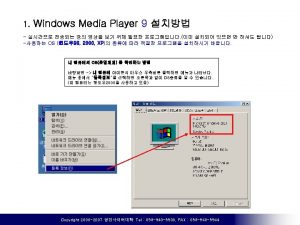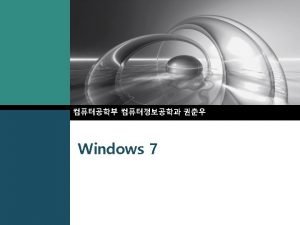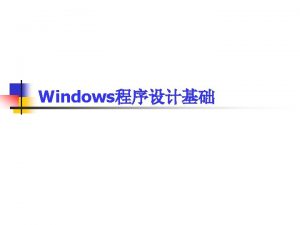Windows 3 1 GROUP 1 MARCUS AGONCILLO VIEA









- Slides: 9

Windows 3. 1 GROUP 1: MARCUS AGONCILLO VIEA TALLA BIANCA FRANCISCO EDWARD CHOY JUSTIN PEREZ

History �There were 4 versions of Windows 3. 1 a. Base version b. versions with special font, namely Windows 3. 1 for Central and Eastern Europe and Windows 3. 1 J c. Windows 3. 11, an upgraded version d. Modular Windows, a special version of Windows 3. 1 designed to run on the Tandy Video Information System.

Timeline April 6, 1992 – Windows 3. 1 is released. Oct 27, 1992 – Windows for Workgroups 3. 1 Oct 27, 1993 – Windows 3. 11 Aug 11, 1993 – Windows for Workgroups 3. 11

Base version � Windows 3. 1 (originally codenamed Janus, of which two betas were published), released on April 1992, includes a True. Type font system (and a set of highly legible fonts already installed), which effectively made Windows a serious desktop publishing platform for the first time. Similar functionality was available for Windows 3. 0 through the Adobe Type Manager (ATM) font system from Adobe. � Windows 3. 1 was designed to have backward compatibility with older Windows platforms. As with Windows 3. 0, version 3. 1 had File Manager and Program Manager, but unlike all previous versions, Windows 3. 1 and later support 32 -bit disk access, cannot run in real mode, and included Minesweeper instead of Reversi (though Reversi was included in some copies).

Versions with special font �A special version named Windows 3. 1 for Central and Eastern Europe was released that allowed the use of Cyrillic and had fonts with diacritical marks characteristic of Central and Eastern European languages. Microsoft, which introduced its own codepage (Windows 1250) and supported its use in violation of many countries' ISO standards (e. g. , the official Polish codepage is ISO-8859 -2, which was ignored by Microsoft but is supported by contemporary Internet Explorer versions). Similarly, Microsoft also released Windows 3. 1 J with support for the Japanese language, which shipped 1. 46 million copies in its first year on the market (1993) in Japan.

Windows 3. 11 �On 31 December 1993, Microsoft released an update for Windows 3. 1 that (aside from installing new files) changes the Windows version displayed in "About" dialog boxes to 3. 11. Thus, Windows 3. 11 is not a standalone version of Windows, but rather a software update from Windows 3. 1, much like modern Windows service packs. For those who did not own Windows 3. 1, full disk sets of Windows 3. 11 were available at the time.

Modular Windows �Modular Windows is a special version of Windows 3. 1, designed to run on the Tandy Video Information System.

Why? � Windows 3. 0 (1990) and Windows 3. 1 (1992) improved the design, mostly because of virtual memory and loadable virtual device drivers (Vx. Ds) which allowed them to share arbitrary devices between multitasked DOS windows. [citation needed] Also, Windows applications could now run in protected mode (when Windows was running in Standard or 386 Enhanced Mode), which gave them access to several megabytes of memory and removed the obligation to participate in the software virtual memory scheme. They still ran inside the same address space, where the segmented memory provided a degree of protection, and multi-tasked cooperatively. For Windows 3. 0, Microsoft also rewrote critical operations from C into assembly, making this release faster and less memory-hungry than its predecessors. [citation needed] With the introduction of the Windows for Workgroups 3. 11, Windows was able to bypass DOS for file management operations using 32 -bit file access – wikipedia. org

Sources: �Wikipedia. org �Guidebookgallery. org
















